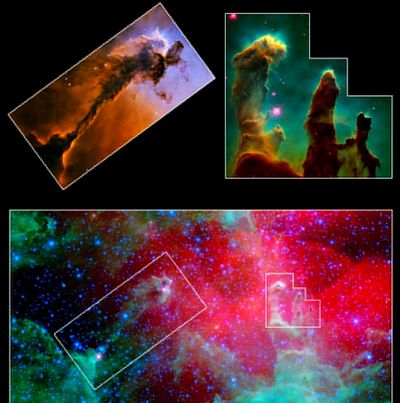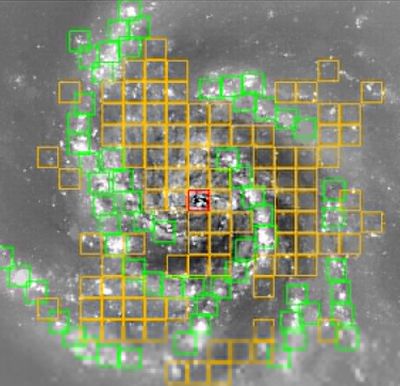The star formation rate in galaxies varies greatly both across different galaxy types and over galactic time scales. MPA astronomers have been trying to gain insight into how the interstellar medium may change in different galaxies by studying molecular gas in a wide variety of galaxies, ranging from gas-poor, massive ellipticals to strongly star-forming irregulars, and in environments ranging from inner bulges to outer disks. They find that the gas depletion time depends both on the strength of the local gravitational forces and the star formation activity inside the galaxy.
Molecular clouds are clouds in galaxies consisting predominantly of molecular hydrogen. They are stellar nurseries where the gas reaches high enough densities to form new stars and planetary systems. Molecular clouds are highly complex structures. Figure 1 shows a Hubble Space Telescope image of the Eagle Nebula, a nearby molecular cloud with a highly filamentary and irregular structure.
In the neighbourhood of our Sun, molecular clouds make up only 1 % of the total volume of the interstellar medium and form stars at modest rates of a few solar masses per year. In the early Universe, however, there is mounting evidence that galaxies contain much more molecular gas and therefore they can form stars at rates up to a thousand times higher than in our Milky Way. The densities and pressures in the interstellar media of these early galaxies are also orders of magnitude higher than in the solar neighbourhood, and it is unlikely that molecular clouds in these systems are the same as the very well-studied Eagle nebula.

Fig. 1: Eagle Nebula imaged by Hubble Space Telescope.
Credit: NASA, ESA/Hubble and the Hubble Heritage Team (STScI/AURA)

Fig. 2: Top: This plot is linking the depletion time and a specific combination of star formation rate (SFR) and stellar surface density. Each data point represents a grid cell of 1kpc x 1kpc size within different structures of the galaxies analysed. Bottom: The optical image of one of the galaxies in the sample, NGC 5457. Coloured squares show grids cells, with 1 kpc on a side, in the arm (green), interarm (yellow) and bulge (red) regions.
In recent work, the MPA group studied variations in the relation between the local density of molecular gas and newly formed stars. They used this as a diagnostic of changing conditions within the interstellar medium. According to standard theory, molecular clouds exist in a balance between gravitational forces, which work to collapse the cloud, and pressure forces (primarily from the gas), which work to keep the cloud from collapsing. When these forces fall out of balance, such as can happen in a supernova shock wave, the cloud begins to collapse and fragment into smaller and smaller pieces. The smallest of these fragments begin contracting and become proto-stars.
Gravitational forces vary significantly from one galaxy to the next, as well as in different regions of the same galaxy. At the centre of a giant elliptical galaxy, gravity is much higher than in the outskirts of a small dwarf irregular. Likewise, the incidence of supernova explosions can differ drastically between different galaxies and between different locations within the same galaxy. Variations in the ratio of the density of molecular gas to young stars (commonly referred to as the depletion time of the molecular gas) may thus be expected as a consequence of these changing conditions.
The main result (see Figure 2) from the MPA group's analysis is that the rate at which molecular gas forms new stars is set BOTH by gravity (as measured by the local surface density of stars in the galaxy) and by the local star formation activity level in the galaxy, which in turn will determine the incidence of supernova-driven shock waves in the interstellar medium. Molecular gas depletion times are shortest in regions where gravity is strong and where the star formation activity is high, particularly in galaxy bulges with gas and ongoing star formation.
Reaching this conclusion required very careful analysis of a variety of data sets at different wavelengths. In particular, star formation rates derived from the combination of infrared images that trace young stars embedded inside dusty clouds and far-ultraviolet images that trace stars that have migrated outside these clouds, are crucial for pinpointing these relations as accurately as possible. In future, new state-of-the-art interferometric radio telescopes, in particular the Atacama Large Millimeter/submillimeter Array (ALMA), will allow us to understand the detailed structure of molecular clouds in regions of high gravity in much more detail.
For a little more insight into the project see this:
http://www.mpa-garching.mpg.de/mpa/research/current_research/hl2015-7/hl2015-7-en.html




